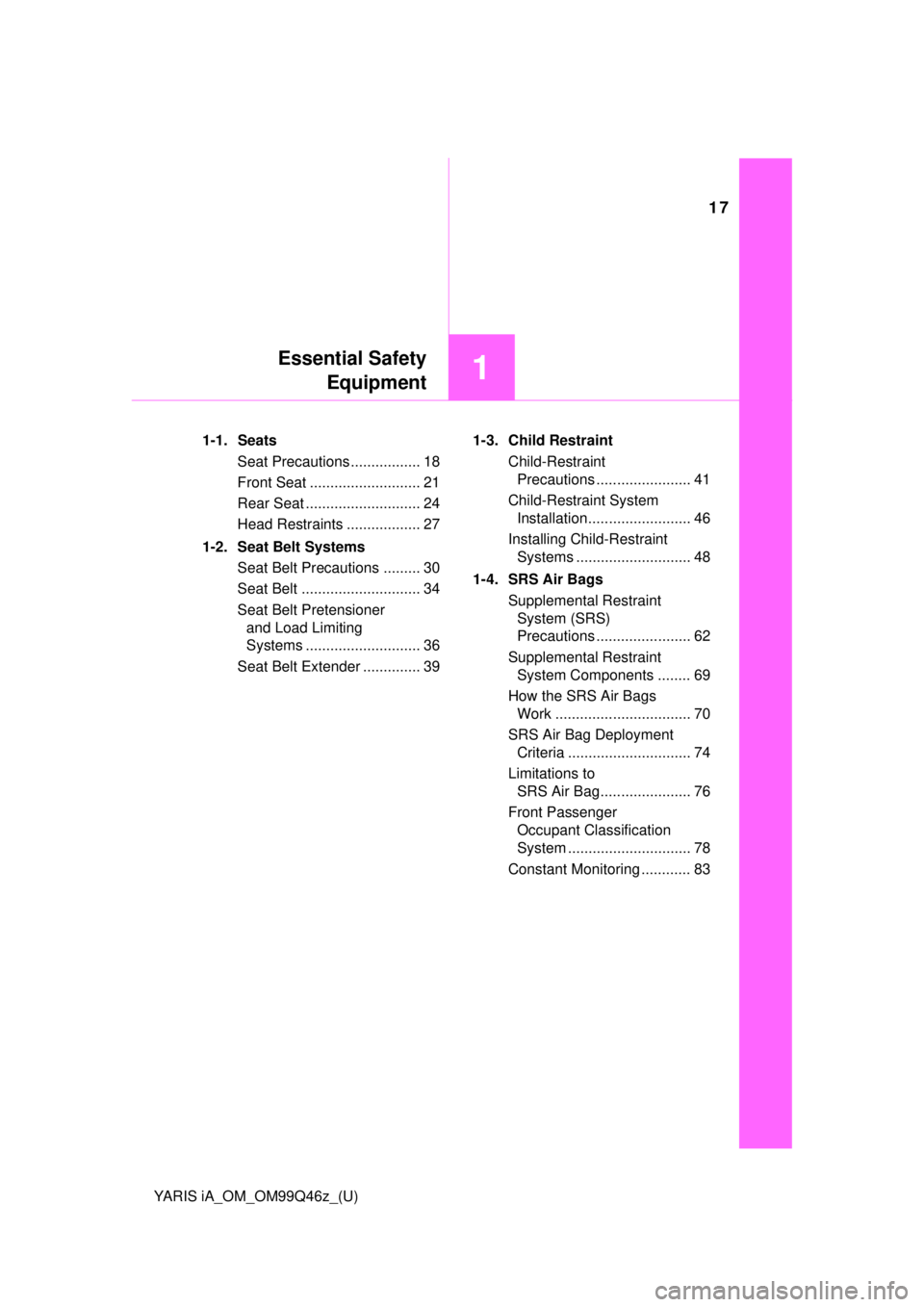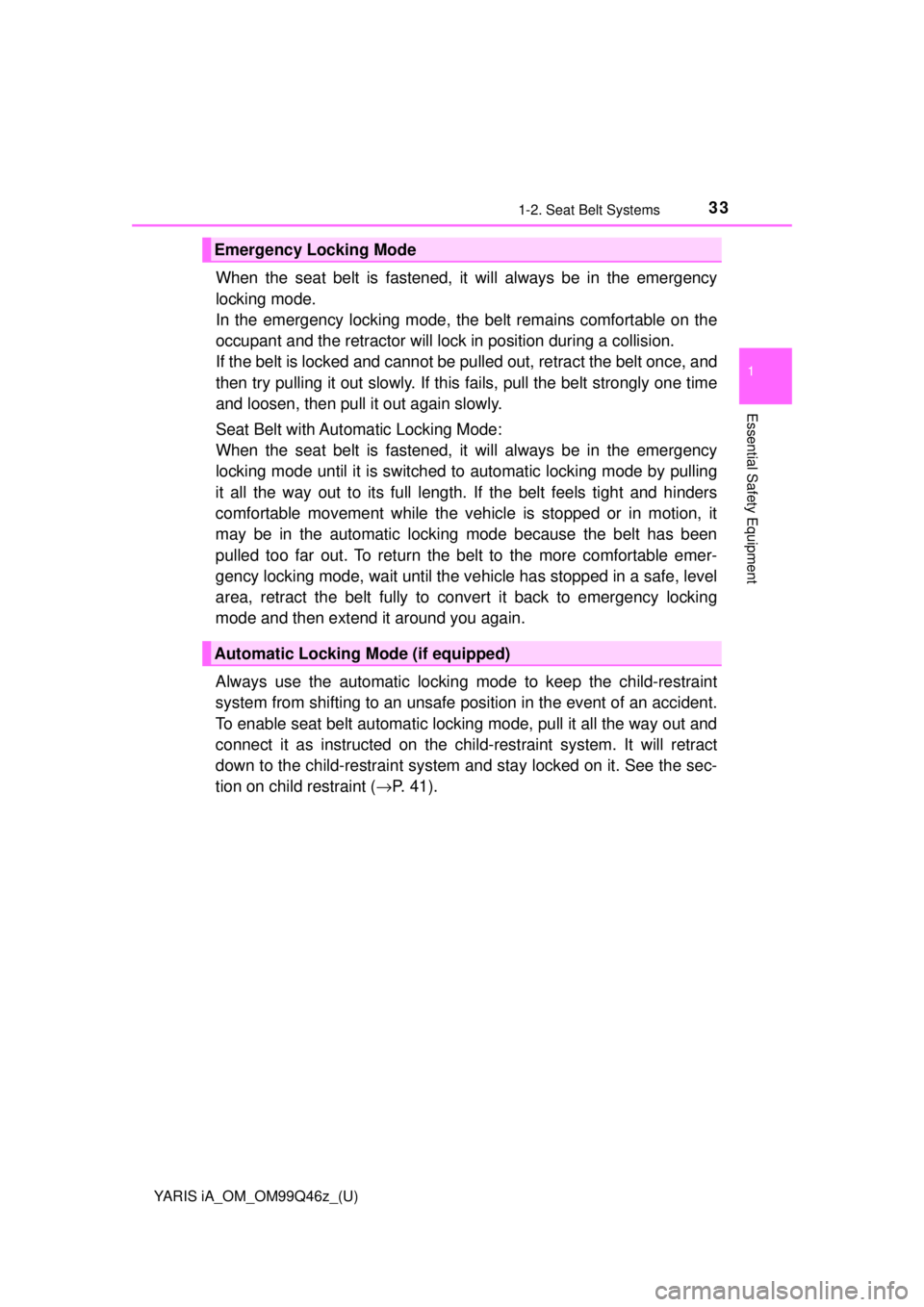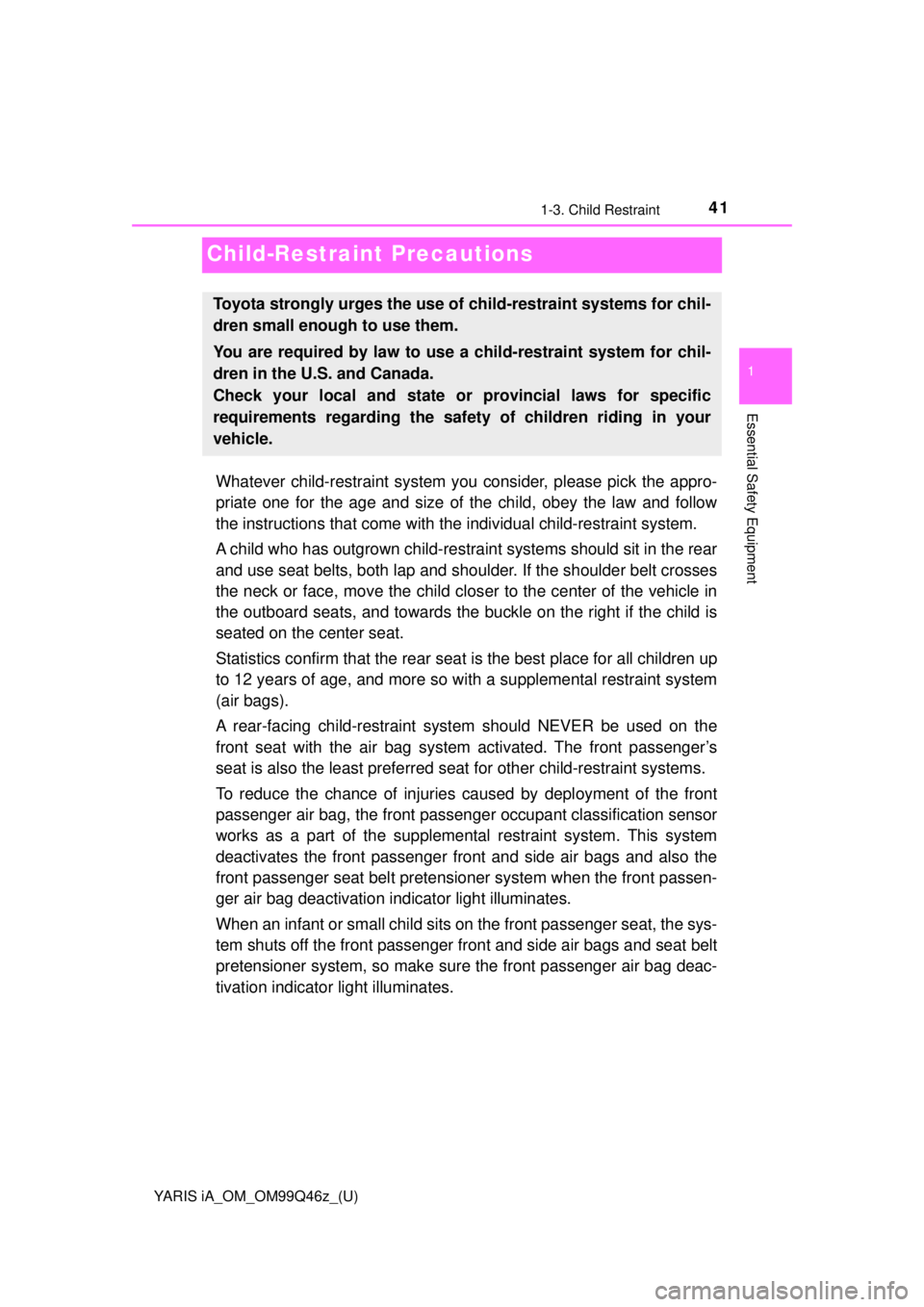2018 TOYOTA YARIS iA child restraint
[x] Cancel search: child restraintPage 1 of 576

YARIS iA_OM_OM99Q46z_(U)
Pictorial IndexInterior, exterior views and part identification of
your Toyota.
1Essential Safety
EquipmentImportant information about safety equipment,
including seats, seat belt system, child-restraint
systems and SRS air bags.
2Before DrivingUse of various features, including keys, doors,
mirrors and windows.
3When DrivingInformation concerning safe driving and stopping.
4Interior FeaturesUse of various features for ride comfort, including
air-conditioning and audio system.
5Maintenance and
CareHow to keep your Toyota in top condition.
6If Trouble ArisesHelpful information on what to do if a problem
arises with the vehicle.
7
Customer Information
and Reporting Safety
DefectsImportant consumer information including
warranties and add-on equipment.
8SpecificationsTechnical information about your Toyota.
IndexSearch alphabetically
Page 2 of 576

TABLE OF CONTENTS2
YARIS iA_OM_OM99Q46z_(U)How to Use This Manual................ 9
Pictorial Index .............................. 12
1-1. Seats
Seat Precautions ................. 18
Front Seat ........................... 21
Rear Seat ............................ 24
Head Restraints .................. 27
1-2. Seat Belt Systems Seat Belt Precautions.......... 30
Seat Belt.............................. 34
Seat Belt Pretensioner and Load Limiting
Systems ............................ 36
Seat Belt Extender .............. 39
1-3. Child Restraint Child-Restraint Precautions ....................... 41
Child-Restraint System Installation ......................... 46
Installing Child-Restraint Systems ............................ 48 1-4. SRS Air Bags
Supplemental Restraint System (SRS)
Precautions ....................... 62
Supplemental Restraint System Components ......... 69
How the SRS Air Bags Work .................................. 70
SRS Air Bag Deployment Criteria ............................... 74
Limitations to SRS Air Bag ...................... 76
Front Passenger Occupant Classification
System .............................. 78
Constant Monitoring ............ 83
2-1. Keys Keys..................................... 86
Keyless Entry System.......... 88
2-2. Door and Locks Door Locks .......................... 94
Trunk Lid............................ 103
2-3. Fuel and Emission Fuel and Engine Exhaust Precautions ..................... 107
Fuel-Filler Lid and Cap ...... 110
1Essential Safety
Equipment
2Before Driving
Page 17 of 576

17
YARIS iA_OM_OM99Q46z_(U)
Essential SafetyEquipment1
1-1. Seats
Seat Precautions ................. 18
Front Seat ........................... 21
Rear Seat ............................ 24
Head Restraints .................. 27
1-2. Seat Belt Systems Seat Belt Precautions ......... 30
Seat Belt ............................. 34
Seat Belt Pretensioner and Load Limiting
Systems ............................ 36
Seat Belt Extender .............. 39 1-3. Child Restraint
Child-Restraint Precautions ....................... 41
Child-Restraint System Installation......................... 46
Installing Child-Restraint Systems ............................ 48
1-4. SRS Air Bags Supplemental Restraint System (SRS)
Precautions ....................... 62
Supplemental Restraint System Components ........ 69
How the SRS Air Bags Work ................................. 70
SRS Air Bag Deployment Criteria .............................. 74
Limitations to SRS Air Bag...................... 76
Front Passenger Occupant Classification
System .............................. 78
Constant Monitoring ............ 83
Page 19 of 576

YARIS iA_OM_OM99Q46z_(U)
191-1. Seats
1
Essential Safety Equipment
WARNING
■Do not drive with either front seats reclined
Sitting in a reclined position while the vehicle is moving is dangerous
because you do not get the full protection from seat belts. During sudden
braking or a collision, you can slide under the lap belt and suffer serious
internal injuries. For maximum protection, sit well back and upright.
■ Do not place an object such as a cushion between the seatback and
your back
Putting an object such as a cushion between the seatback and your back is
dangerous because you will be unable to maintain a safe driving posture
and the seat belt cannot function at its full capacity in a collision, which
could result in a serious accident, injury or death.
■ Do not place objects under the seat
The object could get stuck and cause the seat to not be fixed securely, and
result in an accident.
■ Do not stack cargo high er than the seatbacks
Stacking luggage or other cargo higher than the seatbacks is dangerous.
During sudden braking or a collision, objects can fly around and become
projectiles that may hit and injure passengers.
■ Make sure luggage and cargo is secured before driving
Not securing cargo while driving is dangerous as it could move or be
crushed during sudden braking or a collision and cause injury.
■ Never allow a passenger to sit or stand on the folded seatback while
the vehicle is moving
Driving with a passenger on the folded seatback is dangerous. Allowing a
child to sit up on the folded seatback while the vehicle is moving is particu-
larly dangerous. In a sudden stop or even a minor collision, a child not in a
proper seat or child-restraint system and seat belt could be thrown forward,
back or even out of the vehicle resulting in serious injuries or death. The
child in the baggage area could be thrown into other occupants and cause
serious injury.
■ Never give the car keys to children an d do not allow them to play in the
vehicle
Playing with the folding rear seats is dangerous. Once the seatbacks are
back up, a child in the trunk would not be able to get out the way they had
entered. If you have small children, keep the seatbacks locked.
Page 30 of 576

30
YARIS iA_OM_OM99Q46z_(U)
1-2. Seat Belt Systems
Seat Belt Precautions
All of the seat belt retractors are designed to keep the lap/shoulder
belts out of the way when not in use.
The driver’s seat belt has no prov isions for child-restraint systems and
has only an emergency locking mode. The driver may wear it comfort-
ably, and it will lock during a collision.
However, the front passenger’s seat and all rear lap/shoulder belt
retractors operate in two modes: emergency locking mode, and for
child-restraint systems, automatic locking mode. While we recom-
mend you put all children in the rear seats, if you must use the front
passenger seat for a child, slide t he front passenger seat as far back
as possible and make sure any child-r estraint system is secured prop-
erly.
Seat belts help to decrease the possibility of severe injury
during accidents and sudden st ops. Toyota recommends that
the driver and all passengers always wear seat belts.
WARNING
■ Always wear your seat belt and ma ke sure all occupants are properly
restrained
Not wearing a seat belt is extremely dangerous. During a collision, occu-
pants not wearing seat belts could hit someone or things inside the vehicle
or even be thrown out of the vehicle. They could be seriously injured or
even killed. In the same collision, occupants wearing seat belts would be
much safer.
Page 33 of 576

YARIS iA_OM_OM99Q46z_(U)
331-2. Seat Belt Systems
1
Essential Safety Equipment
When the seat belt is fastened, it will always be in the emergency
locking mode.
In the emergency locking mode, the belt remains comfortable on the
occupant and the retractor will lock in position during a collision.
If the belt is locked and cannot be pulled out, retract the belt once, and
then try pulling it out slowly. If this fails, pull the belt strongly one time
and loosen, then pull it out again slowly.
Seat Belt with Automatic Locking Mode:
When the seat belt is fa stened, it will always be in the emergency
locking mode until it is switched to automatic locking mode by pulling
it all the way out to its full length . If the belt feels tight and hinders
comfortable movement while the vehicle is stopped or in motion, it
may be in the automatic locking mode because the belt has been
pulled too far out. To return the belt to the more comfortable emer-
gency locking mode, wait until the ve hicle has stopped in a safe, level
area, retract the belt fully to conv ert it back to emergency locking
mode and then extend it around you again.
Always use the automatic locking mode to keep the child-restraint
system from shifting to an unsafe pos ition in the event of an accident.
To enable seat belt automatic locking mode, pull it all the way out and
connect it as instructed on the chil d-restraint system. It will retract
down to the child-restrai nt system and stay locked on it. See the sec-
tion on child restraint ( →P. 41).
Emergency Locking Mode
Automatic Locking Mode (if equipped)
Page 40 of 576

40
YARIS iA_OM_OM99Q46z_(U)
1-2. Seat Belt Systems
WARNING
■Do not use an extender that is too long
Using an extender that is too long is dangerous. The seat belt will not fit
properly. In an accident, the seat belt will not provide adequate protection
and you could be seriously injured. Do not use the extender or choose one
shorter in length if the distance between the extender’s buckle and the cen-
ter of the user’s body is less than 6 in. (150 mm).
■ Do not leave a seat belt extender connected to the buckle
Leaving a seat belt extender connected to the buckle without using the seat
belt is dangerous. When the seat belt extender is connected to the driver’s
seat belt buckle (or front passenger’s seat belt buckle), the SRS driver’s (or
front passenger’s) air bag system will determine that the driver (or front pas-
senger) is wearing the seat belt even if the driver (or front passenger) is not
wearing it. This condition could cause the driver’s (or front passenger’s) air
bag to not activate correctly and result in death or serious injury in the event
of collision. Always wear the seat belt with the seat belt extender.
■ Do not use the seat belt extender when installing a child-restraint sys-
tem on the front or rear passenger seat
Using a seat belt extender to fasten a child-restraint system on any seat is
dangerous. Always follow the child-restraint system manufacturer’s installa-
tion instructions and never use a seat belt extender.
Page 41 of 576

41
YARIS iA_OM_OM99Q46z_(U)
1-3. Child Restraint
1
Essential Safety Equipment
Child-Restraint Precautions
Whatever child-restraint system you consider, please pick the appro-
priate one for the age and size of the child, obey the law and follow
the instructions that come with the individual child-restraint system.
A child who has outgrown child-restra int systems should sit in the rear
and use seat belts, both lap and shoulder. If the shoulder belt crosses
the neck or face, move the child clos er to the center of the vehicle in
the outboard seats, and towards the buckle on the right if the child is
seated on the center seat.
Statistics confirm that the rear seat is the best place for all children up
to 12 years of age, and more so with a supplemental restraint system
(air bags).
A rear-facing child-restraint syst em should NEVER be used on the
front seat with the air bag system activated. The front passenger’s
seat is also the least preferred seat for other child-restraint systems.
To reduce the chance of injuries caused by deployment of the front
passenger air bag, the front passen ger occupant classification sensor
works as a part of the supplement al restraint system. This system
deactivates the front passenger front and side air bags and also the
front passenger seat bel t pretensioner system when the front passen-
ger air bag deactivation indicator light illuminates.
When an infant or small child sits on the front passenger seat, the sys-
tem shuts off the front passenger front and side air bags and seat belt
pretensioner system, so make sure the front passenger air bag deac-
tivation indicator light illuminates.
Toyota strongly urges the use of child-restraint systems for chil-
dren small enough to use them.
You are required by law to use a child-restraint system for chil-
dren in the U.S. and Canada.
Check your local and state or provincial laws for specific
requirements regarding the safety of children riding in your
vehicle.